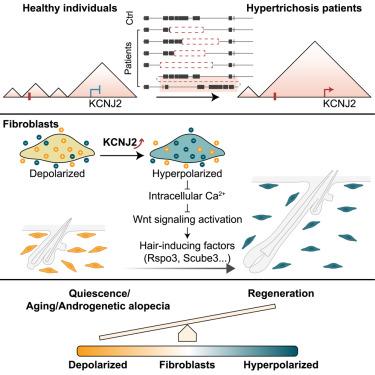Fibroblast bioelectric signaling drives hair growth
IF 42.5
1区 生物学
Q1 BIOCHEMISTRY & MOLECULAR BIOLOGY
引用次数: 0
Abstract
Hair loss affects millions globally, significantly impacting quality of life and psychological well-being. Despite its prevalence, effective strategies for promoting human hair growth remain elusive. By investigating congenital generalized hypertrichosis terminalis (CGHT), a rare genetic disorder characterized by excessive hair growth, we discover that chromatin deletions or an inverted duplication disrupt the topologically associating domain (TAD), leading to the upregulation of the potassium channel KCNJ2 in dermal fibroblasts. Mouse genetics demonstrate that KCNJ2-mediated membrane hyperpolarization in dermal fibroblasts promotes hair growth by enhancing fibroblasts Wnt signaling responses, involving a reduction in intracellular calcium levels. Notably, fibroblast membrane potential oscillates during the normal hair cycle, with hyperpolarization specifically associated with the growth phase. Inducing fibroblast membrane depolarization delays the growth phase, while KCNJ2-mediated hyperpolarization rescues hair loss in aging and androgenetic alopecia models. These results uncover a previously unrecognized role of fibroblast bioelectricity in tissue regeneration, offering novel therapeutic avenues for hair loss treatment.

成纤维细胞生物电信号驱动头发生长
脱发影响着全球数百万人,严重影响着生活质量和心理健康。尽管它很普遍,但促进人类头发生长的有效策略仍然难以捉摸。通过研究先天性广泛性终末多毛症(CGHT),一种罕见的以毛发过度生长为特征的遗传疾病,我们发现染色质缺失或反向复制破坏了拓扑相关结构域(TAD),导致真皮成纤维细胞中钾通道KCNJ2的上调。小鼠遗传学证明,kcnj2介导的真皮成纤维细胞膜超极化通过增强成纤维细胞Wnt信号反应,包括降低细胞内钙水平,促进头发生长。值得注意的是,在正常的毛发周期中,成纤维细胞膜电位振荡,超极化与生长期特别相关。诱导成纤维细胞膜去极化可延缓生长阶段,而kcnj2介导的超极化可挽救衰老和雄激素性脱发模型中的脱发。这些结果揭示了成纤维细胞生物电在组织再生中的作用,为脱发治疗提供了新的治疗途径。
本文章由计算机程序翻译,如有差异,请以英文原文为准。
求助全文
约1分钟内获得全文
求助全文
来源期刊

Cell
生物-生化与分子生物学
CiteScore
110.00
自引率
0.80%
发文量
396
审稿时长
2 months
期刊介绍:
Cells is an international, peer-reviewed, open access journal that focuses on cell biology, molecular biology, and biophysics. It is affiliated with several societies, including the Spanish Society for Biochemistry and Molecular Biology (SEBBM), Nordic Autophagy Society (NAS), Spanish Society of Hematology and Hemotherapy (SEHH), and Society for Regenerative Medicine (Russian Federation) (RPO).
The journal publishes research findings of significant importance in various areas of experimental biology, such as cell biology, molecular biology, neuroscience, immunology, virology, microbiology, cancer, human genetics, systems biology, signaling, and disease mechanisms and therapeutics. The primary criterion for considering papers is whether the results contribute to significant conceptual advances or raise thought-provoking questions and hypotheses related to interesting and important biological inquiries.
In addition to primary research articles presented in four formats, Cells also features review and opinion articles in its "leading edge" section, discussing recent research advancements and topics of interest to its wide readership.
 求助内容:
求助内容: 应助结果提醒方式:
应助结果提醒方式:


